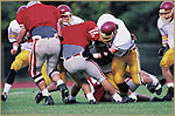

|
|
Monthly Feature & Newsletter
|
Features & Newsletter Archive |
December 31,2014 The Biggest Sports Injury Story of 2014 The biggest, most pervasive sports injury story of the year has to be the effects of concussions on football players. From professional to college to high school players, sports-related brain injuries have become a concern in football. Studies show that the effects of multiple concussions can be long lasting, including depression, cognitive problems, and even an increased risk of Alzheimerís disease.  Thousands of retired National Football League (NFL) players who have suffered concussion-related injuries and disabilities filed a class-action lawsuit against the league, claiming that it did not do enough to protect their health and did not tell them about the long-term dangers of repeated head injuries. Public awareness of the dangers of concussions was again raised after Ohio State University defensive lineman Kosta Karageorge, who had a history of concussions during his college career, was found dead in late November as the result of an apparent self-inflicted gunshot wound. In early December, a study found that high school football players may develop impact-related brain changes over the course of a single season. Players who experienced higher levels of head impacts showed the most changes, even in the absence of concussion. Denver Broncos wide receiver Wes Welker may have worn a larger helmet to help him prevent further concussions in this yearís Super Bowl game, but even hits to the head that donít result in concussions can affect athletesí brains and may impact learning. This makes some athletes more susceptible to repeated head impacts that do not involve concussions. NEW LAWS, MORE AWARENESS The good news is that new laws regulating concussion treatment plus awareness of concussions have resulted in a large increase in the treatment of concussion-related injuries for school-age athletes, according to a new study published online on December 22, 2014 in JAMA Pediatrics. A University of Michigan study designed to evaluate the impact of new concussion laws found a 92% increase in children seeking medical assistance for concussions in states with the legislation in place. States without concussion laws showed a 75% increase in those seeking injury-related health care. "There are two stories here," said senior author Steven Broglio, Associate Professor at the University of Michigan School of Kinesiology and Director of the NeuroSport Research Laboratory. "First, the legislation works. The other story is that broad awareness of an injury has an equally important effect. We found large increases in states without legislation, showing that just general knowledge plays a huge part." As of 2014, all states and the District of Columbia have passed laws that outline medical care for young athletes. The laws differ slightly, but most call for education of coaches or students, the immediate removal of an athlete from a game, or medical clearance before an athlete can return to a sport. TECHNOLOGICAL ADVANCES Another way to prevent brain injuries may be to add a vision-based test to evaluate athletes on the sidelines. This may allow sports medicine doctors to better detect more athletes with concussion more quickly, which is particularly important since not all athletes reliably report their symptoms of concussion, including any vision problems. Others are taking a more technological approach to protecting players. Several companies have put sensors or magnets in helmets or mouth guards to detect or absorb the forces of hits to the head, with the hope of further reducing the risk of brain injury to young athletes. The sensors cannot prevent or diagnose a concussion, but they can alert coaches and trainers to take the proper steps to determine if a player has a concussion. Letís hope that these and other safety measures are made at all levels of football and translate into fewer concussions next year. |
|
|
|
Disclaimer and Copyright · Site design by Marketorial.com
|